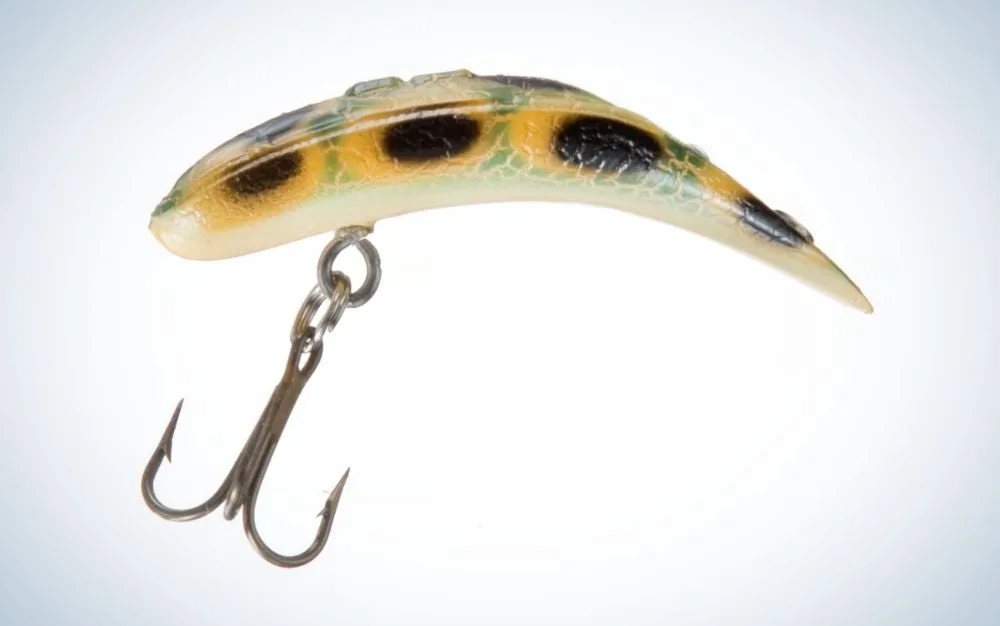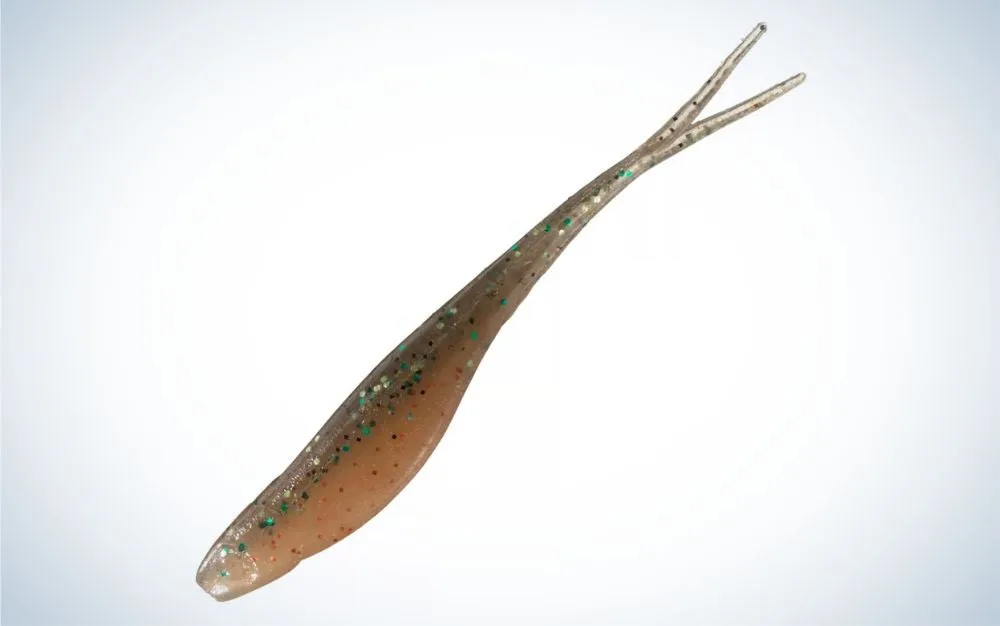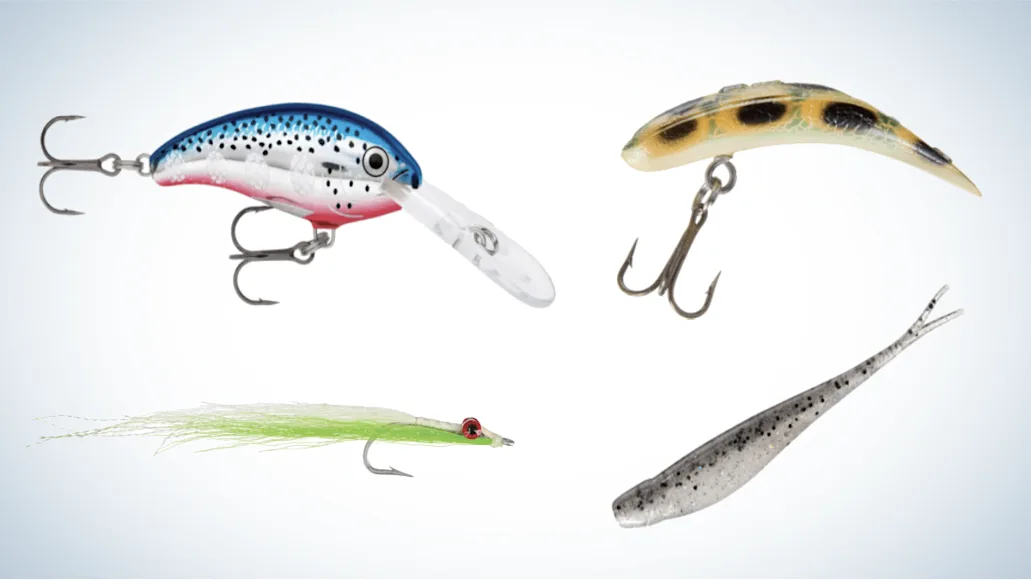_We may earn revenue from the products available on this page and participate in affiliate programs. Learn more ›
_
Best for the Shore

Rapala Shad Dancer Crankbait
LEARN MORE
Summary
A versatile bait with big action in a small package.
Best Trolling

Yakima Bait Flatfish
LEARN MORE
Summary
When trolled at slow to moderate speeds, the distinctive wide wiggle action has been drawing strikes longer than I’ve been alive.
Best Jigging

Z-Man Scented Jerk ShadZ
LEARN MORE
Summary
The split-tail design simulates an erratic baitfish action that even makes me want to eat it.
It’s essential to match lures for lake trout to the size of the predominant baitfish in the waters where you wet a line as the voracious predators love to eat other fish. The largest of the chars, they can reach sizes measured in pounds rather than inches, with 15 to 40 pound fish not uncommon. Lakers or mackinaw are found across northern North America and are native to Alaska, Canada, and the northeastern United States. Time of year and water temperature are critical factors in finding them—fish may be near shore and shallow early in the season and then up to 200 feet deep in the summer months.
Though trolling is often the first angling tactic associated with these fish, casting and jigging lures are both methods that can be surprisingly effective. Perhaps the greatest challenge is trying to narrow down the overwhelming array of choices available to anglers today. Here are some suggestions to help you figure out the best lures for lake trout.
Best for the Shore: Rapala Shad Dancer Crankbait
Best Trolling: Yakima Bait Flatfish
Best Jigging: Z-Man Scented Jerk ShadZ
Best Fly Fishing: Clouser Deep Minnow
How We Chose The Best Lures for Lake Trout
My introduction to Salvelinus namaycush (lake trout) came years ago on a trip to Gangler’s North Seal Lodge in Manitoba. When I moved to the Finger Lakes Region of New York, I was pleasantly surprised to find these hard-fighting piscivores thriving in the deep natural lakes of the region. To round out my selection process, I’ve also sought out the input of experienced anglers and professional guides.
The Best Lures for Lake Trout: Reviews & Recommendations
Best for the Shore: Rapala Shad Dancer Crankbait
Best for the Shore

Why It Made the Cut: A versatile bait with big action in a small package.
Key Features
Length: 2 ¾ inches (also available in 1 ½- and 2-inch sizes)
Running Depth: 9 to 14 feet
Primary Fishing Method(s): Casting, trolling
Pros
Available in 24 colors to imitate various baits and meet different water conditions
Fishes well both casting and trolling
Strong distinct wobble action
Durable construction
A great multi-species bait
Cons
Not good for deeper casting presentations
I bought my first Rapalas with lawn mowing money when I was ten years old—and they’ve had a place in my tackle boxes ever since. Rapala is well known in the fishing market for its fish-catching baits. The Shad Dancer design is actually a synthesis of attributes from two of Rapala’s other successful lures: the Shad Rap and the Tail Dancer. Merging the action of the Tail Dancer with the shape characteristic of the Shad Rap has proven to be a winning combination.
For shore fishing, I like a lure that allows me to cover water effectively and a crankbait is hands down one of the best baits for doing this. I can walk a shoreline, fancast a given area, and feel confident that any hungry lakers prowling that water will see this bait. More importantly, that enticing wobble has a way of getting fish to eat.
My favorite colors include blue flash, firetiger, silver (Rapala’s classic black back and silver sides), purpledescent, Yellow Perch and silver fluorescent chartreuse. If I had to narrow that down, I’d go with the silver and silver fluorescent chartreuse, which give you a basic natural tone and a brighter attractive look. Try both and let the fish tell you which they prefer.
The aggressive tight wobble of the Shad Dancer can readily be felt, letting you know the lure is tracking and fishing properly throughout the retrieve. Also, on more subtle grabs when the fish continues swimming toward you after eating the bait, you notice the absence of that wobble—set the hook!
Best Trolling: Yakima Bait Flatfish
Best Trolling

Why It Made the Cut: When trolled at slow to moderate speeds, the distinctive wide wiggle action has been drawing strikes longer than I’ve been alive. It’s hard to argue with a track record like that.
Key Features
Length: 1 to 6 inches
Fishing Depth: 20 feet maximum depth (without weighted assistance)
Primary Fishing Method(s): Trolling
Pros
Available in dozens of length and color/pattern options
Incredible wobbling action at slow to medium trolling speeds
Consistent swimming action
Cons
Requires added weight to fish in depths greater than 20 feet
I can still picture my first Yakima Flatfish—orange with black spots (Orange Flo in the Yakima Bait index)—and wow, did it catch fish! Designed by Charlie Helin in the early 1900s, the Yakima Flatfish has proven itself for over a hundred years.
For lake trout, Yakima Bait has its Flatfish Lake Trout series. These lures measure 6 inches long, weigh 1.82 ounces, and are equipped with #4/0 trebles. Within this series, the T-60 Metallic Silver Clown, Frog, and Metallic Silver Blue (Pirate) are all excellent producers.
These baits are ideal for flatline trolling (no added weight) in shallow water or for trolling behind an inline sinker or downrigger for a deeper presentation. When trolled across shallow humps, Yakima Flatfish can produce fantastic results. The slightly nose-down orientation of the lure will periodically cause it to bump or momentarily “dig in” to the bottom, which in turn causes the lure to work more erratically. This often triggers a strike.
Best Jigging: Z-Man Scented Jerk ShadZ
Best Jigging

Why It Made the Cut: The split-tail design simulates an erratic baitfish action that even makes me want to eat it.
Key Features
Length: 4, 5, and 7 inches
Fishing Depth: 100- to 200-foot depths aren’t a problem
Primary Fishing Method(s): Jigging, casting (slow flutter presentation)
Pros
Erratic action induces strikes
Tough ElaZtech construction makes for extreme durability
Impregnated with natural Pro-Cure Mullet Super Gel scent
Available in 39 color options
Cons
Can “melt” if stored with other more conventional plastic baits
The Z-Man Scented Jerk ShadZ were originally designed for saltwater angling and have definitely made their mark in marine fishing circles. However, as is so often the case, the crossover from salt to sweetwater is undeniable. Rigged on a ¼- to ½-ounce 90-degree jighead, the buoyancy of the Jerk ShadZ causes it to hover horizontally like actual baitfish. When dropped vertically, this bait has a tantalizing action. Once lakers have been located, drop the bait and stop it short above the fish; they will often rise up to take the bait. If not, added jigging action, from subtle to more dramatic, with a finishing pause and hover is usually enough to get a fish to commit.
My must-have colors include pearl, shiner, bad shad, and smelt; for a bright bait that gets fish’s attention, go with electric chicken. An added bonus of this bait is its use in shallow water situations. When fishing shallow structure that holds lakers in the spring and fall, like tributary mouths and rock and rubble humps, this bait can be deadly when fished in a more traditional jerkbait style. The slow, fluttering descent of the bait and erratic movement when worked can result in some jarring strikes.
Best Fly Fishing: Clouser Deep Minnow
Best Fly Fishing

Why It Made the Cut: It gets down, has great movement, and can be tied in an endless variety of sizes and color-schemes. And fish just eat this fly.
Key Features
Length: 5 to 6 inches
Running Depth: 4 to 10 feet (floating or intermediate lines)
Primary Fishing Method(s): Casting
Pros
More fun than the proverbial barrel of monkeys
Effective for varied presentations, from slow and erratic to fast bursts
Can be fished on a floating, intermediate, or faster sinking line
Cons
Limited to spring and fall fishing in the southern portion of the lakers’ range
In fly fishing circles, anglers often talk about the addiction of the grab. Interestingly, they’re often talking about other salmonids, usually browns, rainbows, or steelhead (the lake or ocean-run version of rainbows). Happily for anglers in the know, lake trout also love to grab a streamer.
For everyday fishing, it’s hard to beat the Clouser Deep Minnow. Originally tied for smallmouth bass, this fly has gone from a specific fly to a pattern style that can be modified in countless ways. The large dumbbell eyes are a key to its effectiveness, both allowing it to sink and creating a distinct jigging action that suggests wounded prey. This action rings the dinner bell for any nearby mackinaws.
If you tie your own flies, I’m a bit of a traditionalist so I like bucktail if the hair is long enough. Flash n Slinky Fibre is a great synthetic alternative. Tied in all white, the legendary chartreuse over white (“If it ain’t chartreuse, it ain’t no use”) and blue with silver flash over white are all good color combinations. Be sure to add some flashabou or other flash material between the colored over and under wing layers.
Things to Consider Before Buying The Best Lures for Lake Trout
A wide range of lures can trigger a bite from hungry lakers. There’s no magic bullet that gets it done all the time, though certain artificials definitely stand out from the crowd. Various conditions and considerations factor into the choices we make when pondering the cavernous yaw of our tacklebox, seeking that next flash of inspiration. Here are a few things to keep in mind when selecting the best trout lures
.
Boat vs. Shore Angling
Fishing from a boat for lake trout has definite advantages. The ability to move and find the fish using electronics is the most obvious upside. In the search process, trolling is a viable technique not available to the shore bound angler. Once fish are located, fine-tune lure selection to the method of angling you think will be most effective.
If you’re fishing from shore, it’s safe to say you won’t need trolling lures. However, I want to offer as many different looks as possible and be flexible in my approach to the section of lake in front of me. If you can cover it thoroughly, from deep to shallow and with methods that range from more aggressive to more subtle, you can greatly increase your odds of hooking up.
Season, Water Temperature, and Depth
Each of these factors could easily merit it’s own discussion section. However, they’re also very closely related and interdependent, so it just makes sense to talk about them collectively. Seasonal variations – length of day, amount of sunlight and average temperature ranges drive changes in water temperature. Water temperature, in turn dictates the depths where you’re most likely to find the lakers. Like everything in nature, there’s variability and exceptions but overall, lake trout are very much a coldwater fish. A good basic water temperature range to look for is between 40 and 50 degrees.
Typically, spring and fall can mean finding optimal temperatures in shallow water and near shore. In these situations, fish can often be found between 5 and 20 feet deep; choose lures that shine in these depth ranges, like crankbaits and soft plastic swimbaits. During summer months, warming surface temperatures drive lakers deep, often somewhere near the thermocline. Consequently, choose lures and methods of presentation that allow you to effectively work the depths. Jigging and trolling with downriggers are probably the two most effective modes of deep-water presentation.
Angling Method – Trolling, Vertical Jigging, or Casting
Like all angling, flexibility and versatility equate to more fish caught. Once I find fish—or find a good location—I choose my method of angling. This helps narrow down the lures I might use. Some are quite specialized—I wouldn’t choose my favorite vertical jigging lure if I were planning to fish an aggressive trolling pattern while exploring a new lake.
Other lures can offer more crossover. Classic spoons, such as large Daredevils and Five of Diamonds can be trolled, fished vertically or cast and worked back to the boat or shore. Know the strengths and weaknesses of each lure in your tacklebox and you’ll be more effective in choosing baits that get eaten.
FAQs
Q: What color lures are best for lake trout?
The best lure colors for lake trout fall into two categories: imitative or natural and attractive or “bling.” In the first category, choose lures that suggest the predominant baitfish species—basics like black, silver, gold, white, and pearl are good starting points. In various hard bait offerings, natural colors are often picked for the imitated bait in question, like smelt, shad, alewives, etc.
In the “bling” category, you can find vibrant colors like chartreuse, orange, and firetiger. My best tip is to try lures from both categories when you start your day. If you’re fishing with a partner, one person should go natural and one should go bling. If your location is good and the fish are seeing your baits, they’ll let you know which color style they prefer that day.
Q: What size lure is best for lake trout?
The best size lure for lake trout is one that mimics the size of the most prevalent bait the fish are feeding on. Lake trout have the potential to grow to substantial size and they do this by eating other fish. The size of forage can also vary with the seasons, so pay attention to that as well. When in doubt, a selection of lures in the 4- to 7-inch range should prove effective.
Q: What depth is best for lake trout?
The best depth for lake trout is determined by water temperature. Find water that’s between 40 and 50 degrees and that holds schools of bait. In the spring and fall, this may be shallow, between 5 and 20 feet. Summer heat that warms surface temperatures to the high 50s or above will drive the mackinaw deep. In these conditions, deep humps in 100 to 200 feet of water can be hotspots for lakers. For deep-water fishing, a good fish finder becomes a key piece of equipment, though knowledge of the lake and a contour map can provide enough intel for finding the fish.
Final Thoughts on the Best Lures for Lake Trout
Lake trout are amazing gamefish that grow to prodigious size, fight well, and taste good, too. To successfully target these powerhouses, consider whether you’ll be fishing from a boat or shore, which angling methods you prefer, and the time of year. Choose your lures accordingly, find the cold water and bait, and hang on—the grab of a big laker is something you’ll never forget.
Why Trust Us
For more than 125 years, Field & Stream has been providing readers with honest and authentic coverage of outdoor gear. Our writers and editors eat, sleep, and breathe the outdoors, and that passion comes through in our product reviews. You can count on F&S to keep you up to date on the best new gear. And when we write about a product—whether it’s a bass lure or a backpack—we cover the good and the bad, so you know exactly what to expect before you decide to make a purchase.





